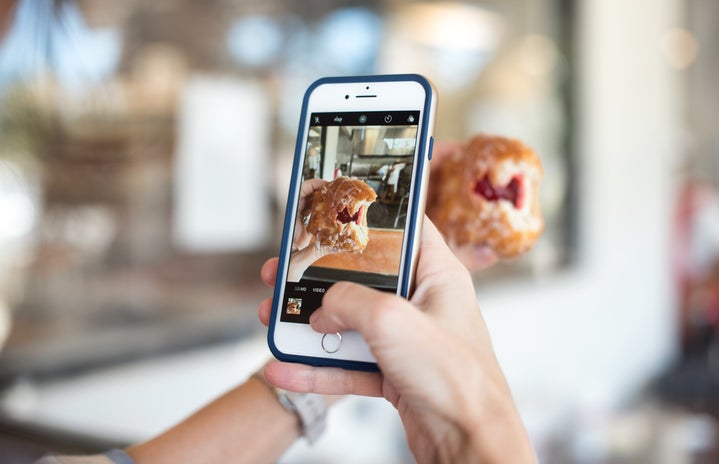Social media has always been a powerful platform to foster fashion and beauty trends. Despite the many benefits of social media sites like Instagram and Youtube, pictures on social media can negatively influence how we look/feel about ourselves. First and foremost, social media can promote false perceptions of dieting and fitness with Instagram Explore pages filled with absurd “diet” plans. These programs advocate for a diet eliminating the consumption of entire food groups, such as a diet composed only of fruit, or diets restricting meals, such as the OMAD diet (One Meal A Day).
In addition to Instagram Explore pages filled with extreme dieting plans, Instagram influencers also claim to follow rigorous diets and encourage their followers to do the same. I’m not implying that all Instagram influencers recommend extreme dieting, but many influencers also photoshop or change some aspect of their posts that can further contribute to their audience participating in these fad diets. Therefore, I am critical of the false notions that these influencers’ photos perpetuate to their vulnerable audience. Instagram users may be under the impression that influencers look exactly like their photos all the time, when in fact, influencers deliberately choose particular times of the day or specific locations to show off certain aspects of their bodies, such as angles where natural light allude to a toner body. For instance, many people – myself included – have flatter stomachs at the beginning of the day. As we have meals throughout the day, our stomachs will look very different. Our stomachs look smaller/toner in the mornings because our bodies digest while we sleep; therefore, because we eat meals throughout the day, our evening bodies and morning bodies look very different. Our stomachs naturally fill up from meals, causing bloating. This is normal for anyone, but due to unrealistic Instagram posts, some people may be fooled into thinking that bloating is abnormal.
While this issue is prevalent to all ages, specifically adolescents, I do believe this matter targets a younger audience — those who were perhaps born into the age of social media. While some of the older generation of instagram users grew up throughout the trend, and thus, are familiar with the rise of editing apps, there are younger adolescents who are not as knowledgeable about the tools used by these influencers. I recently spoke with a friend about her younger sister’s struggles with body image (note: I have both of their permissions to discuss this information). Her sister would complain about how she wasn’t as skinny as her favorite Instagram model, or how she had to go on a diet to achieve her dream body. She was an athlete who based body goals on potentially photoshopped posts. The worst part of it all was that my friend’s sister had just reached seventh grade; she was barely a teenager, but already unsatisfied with her body because of the unattainable body types propagated through fitness inspiration, or “fitspiration,” posts.
Fitspiration refers to the motivation to improve one’s health, and its widespread presence on social media has made teens critical of their body shape as well as specific body parts they believe they need to change. Additionally, detox recipes that consume social media feeds and influencers who advertise diet plans and lifestyles all contribute to young women striving to obtain flawed representations of body image.
Furthermore, because of the growing emergence of social media, it’s almost impossible to avoid seeing these fitness influencers on various platforms, especially Youtube. Although some of them genuinely promote healthy living, others falsely claim their lifestyles guarantee a fit body, which could cause their audience to engage in harmful diets. “Full Day of Eating” and “Work Out with Me” videos can be helpful to audiences, but only if taken with a grain of salt. YouTubers’ diverse viewers have different body types and goals, thus one influencer’s diet and workouts may not be applicable to their entire audience. Uploading these videos are not harmful, yet it’s what the audience interprets out of it that could cause unhealthy habits. If someone were to see a model cut out carbs from her diet, it might influence the viewer to do the same. This mentality can be very dangerous.
However, again, it’s not to say Youtubers that encourage realistic and healthy lifestyles don’t exist. For instance, Dr. Stephanie Buttermore, a former bodybuilder, not only promotes her healthy lifestyle, but also clarifies that the eating habits and workouts that work for her might not be applicable to everyone.
Thus, although social media is a great way to communicate with an audience, it also has its setbacks. Our lifestyles should not be dictated by what we see on Instagram or watch on Youtube. Although some of the advice on these sites is sound, fitness and lifestyle tips are not generalizable. We need to be critical and informed about any form of social media. Each person’s goals are different, and sometimes, social media can negatively influence how we treat our bodies by perpetuating a single ideal of what it means to be fit or attractive. Therefore, we should be mindful that diet plans and “fitspiration” social media posts can often create a false perception of what a healthy lifestyle actually is.


